Swayambhunath
Swayambhu (Devanagari: स्वयम्भू स्तूप; Nepal Bhasa: स्वयंभू; sometimes Swayambu or Swoyambhu) is an ancient religious architecture atop a hill in the Kathmandu Valley, west of Kathmandu city. The Tibetan name for the site means 'Sublime Trees' (Wylie: Phags.pa Shing.kun), for the many varieties of trees found on the hill. However, Shing.kun may be a corruption of the local Nepal Bhasa name for the complex, Swayambhu, meaning 'self-sprung'.[1] For the Buddhist Newars, in whose mythological history and origin myth as well as day-to-day religious practice Swayambhunath occupies a central position, it is probably the most sacred among Buddhist pilgrimage sites. For Tibetans and followers of Tibetan Buddhism, it is second only to Boudha.
| Swayambhu Swayambhu Mahachaitya | |
|---|---|
𑐳𑑂𑐰𑐫𑐩𑑂𑐨𑐸 𑐩𑐵𑐴𑐵𑐔𑐿𑐟𑑂𑐫, 𑐳𑑂𑐫𑐒𑑂𑐐𑐸𑑃 | |
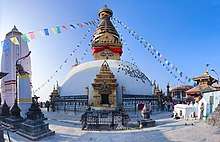 Stupa at Swayambhunath 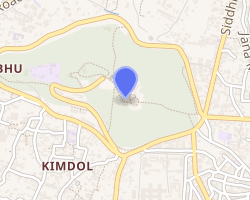
| |
| Religion | |
| Affiliation | Buddhism |
| Location | |
| Location | Swayambhu, Kathmandu |
| Country | Nepal |
| Part of a series on |
| Buddhism |
|---|
 |
|
|
|
| Part of a series on |
| Tibetan Buddhism |
|---|
 |
|
|
|
Practices and attainment |
|
Institutional roles |
|
History and overview |
The complex consists of a stupa, a variety of shrines and temples, some dating back to the Licchavi period. A Tibetan monastery, museum and library are more recent additions. The stupa has Buddha's eyes and eyebrows painted on. Between them, the number one (in Devanagari script) is painted in the fashion of a nose. There are also shops, restaurants and hostels. The site has two access points: a long staircase leading directly to the main platform of the temple, which is from the top of the hill to the east; and a car road around the hill from the south leading to the south-west entrance. The first sight on reaching the top of the stairway is the Vajra. Tsultrim Allione describes the experience:
We were breathless and sweating as we stumbled up the last steep steps and practically fell upon the biggest vajra (thunderbolt scepter) that I have ever seen. Behind this Vajra was the vast, round, white dome of the stupa, like a full solid skirt, at the top of which were two giant Buddha eyes wisely looking out over the peaceful valley which was just beginning to come alive.[2]
Much of Swayambhunath's iconography comes from the Vajrayana tradition of Newar Buddhism. However, the complex is also an important site for Buddhists of many schools, and is also revered by Hindus.
Mythology
According to Swayambhu Purana, the entire valley was once filled with an enormous lake, out of which grew a lotus. The valley came to be known as Swayambhu, meaning "Self-Created." The name comes from an eternal self-existent flame (svyaṃbhu) over which a sūpa was later built.[3]
There are holy monkeys living in the north-west parts of the temple. They are holy because Manjushri, the bodhisattva of wisdom and learning, was raising the hill which the stupa stands on. He was supposed to leave his hair short but he made it grow long and head lice grew. It is said that the head lice transformed into these monkeys.
Manjusri had a vision of the Lotus at Swayambhu and traveled there to worship it. Seeing that the valley could be a good settlement, and to make the site more accessible to human pilgrims, he cut a gorge at Chovar. The water drained out of the lake, leaving the valley in which Kathmandu now lies. The Lotus was transformed into a hill and the flower became the stupa.
History
Swayambhunath is among the oldest religious sites in Nepal. According to the Gopālarājavaṃśāvalī, it was founded by the great-grandfather of King Mānadeva (464-505 CE), King Vṛsadeva, about the beginning of the 5th century CE. This seems to be confirmed by a damaged stone inscription found at the site, which indicates that King Vrsadeva ordered work done in 640 CE.[3]
However, Emperor Ashoka is said to have visited the site in the third century BCE and built a temple on the hill which was later destroyed.
Although the site is considered Buddhist, the place is revered by both Buddhists and Hindus. Numerous Hindu monarch followers are known to have paid their homage to the temple, including Pratap Malla, the powerful king of Kathmandu, who is responsible for the construction of the eastern stairway in the 17th century.[4]
The stupa was completely renovated in May 2010, its first major renovation since 1921[5][6] and its 15th in the nearly 1,500 years since it was built. The Swayambhu Shrine was re-gilded using 20 kg of gold. The renovation was funded by the Tibetan Nyingma Meditation Center of California, and began in June 2008.[7]
At around 5 a.m. on 14 February 2011, Pratapur Temple in the Swayambhu Monument Zone suffered damage from a lightning strike during a sudden thunderstorm.[8]
The Swayambunath complex suffered damage in the April 2015 Nepal earthquake.[9]
Architecture
The stupa consists of a dome at the base, above which is a cubical structure painted with eyes of Buddha looking in all four directions. There are pentagonal toran present above each of the four sides with statues engraved in them. Behind and above the torana there are thirteen tiers. Above all the tiers there is a small space above which the Gajur is present. The stupa has many artifacts inside it.
Symbolism
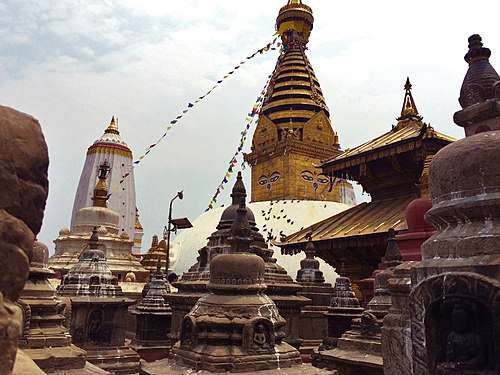
The dome at the base represents the entire world. When a person awakes (represented by eyes of wisdom and compassion) from the bonds of the world, the person reaches the state of enlightenment. The thirteen pinnacles on the top symbolize that sentient beings have to go through the thirteen stages of spiritual realizations to reach enlightenment or Buddhahood.
There is a large pair of eyes on each of the four sides of the main stupa which represent Wisdom and Compassion. Above each pair of eyes is another eye, the third eye. It is said that when Buddha preaches, cosmic rays emanate from the third eye which acts as messages to heavenly beings so that those interested can come down to earth to listen to the Buddha. The hellish beings and beings below the human realm cannot come to earth to listen to the Buddha's teaching, however, the cosmic rays relieve their suffering when Buddha preaches. Between the two eyes (also called Wisdom Eyes), a curly symbol, symbolizing the nose, is depicted which looks like a question mark, which is a Nepali sign of number figure one. This sign represents the unity of all things existing in the world as well as the only path to enlightenment through the teachings of Buddha.
There are carvings of the Panch Buddhas (five Buddhas) on each of the four sides of the stupa. There are also statues of the Buddhas at the base of the stupas. Panch Buddhas are Buddha in a metaphorical sense in Tantrayana. They are Vairochana (occupies the center and is the master of the temple), Akshobhya (faces the east and represents the cosmic element of consciousness), Ratna Sambhava (faces the south and represents the cosmic element of sensation), Amitabha (He represents the cosmic element of Sanjna (name) and always faces the West) and Amoghsiddhi (He represents the cosmic element of confirmation and faces the north).
Each morning before dawn hundreds of Buddhist (Vajrayana) and Hindu pilgrims ascend the steps from the eastern side that lead up the hill, passing the gilded Vajra (Tibetan: Dorje) and two lions guarding the entrance, and begin a series of clockwise circumambulations of the stupa.
Swayambhu Purana
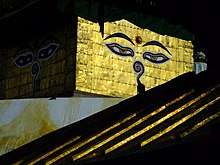
Swayambhu Purana (Devnagari: स्वयम्भू पूराण) is a Buddhist scripture about the origin and development of Kathmandu valley. Swayambhu Purana gives detail of all the Buddhas who came to Kathmandu. It also provides information about the first and the second Buddhas in Buddhism.
Gallery
 Swayambhunath Temple View capture from Kritipur bhag Bhairav
Swayambhunath Temple View capture from Kritipur bhag Bhairav main stupa
main stupa Stairs to Swayambhunath stupa
Stairs to Swayambhunath stupa An evening view of Swayambhunath stupa
An evening view of Swayambhunath stupa Close-up of Swayambhunath stupa
Close-up of Swayambhunath stupa Ajima Temple
Ajima Temple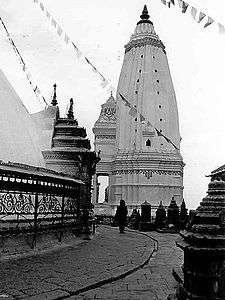 Shikhar style temple erected by king Pratap Malla
Shikhar style temple erected by king Pratap Malla- Buddhist gompa, Swayambhunath
 The hillock of Swayambhu
The hillock of Swayambhu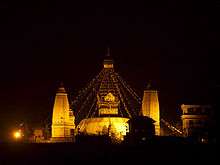 Swayambhunath at night
Swayambhunath at night A monk at Swayambhunath
A monk at Swayambhunath Swayambhunath
Swayambhunath Monkey Temple
Monkey Temple
Footnotes
- Allione, Tsultrim (1986). Women of Wisdom. London: Arkana. xxxiii. ISBN 1-85063-044-5.
- Allione, Tsultrim (1986). Women of Wisdom. London: Arkana. xiv. ISBN 1-85063-044-5.
- Shaha, Rishikesh. Ancient and Medieval Nepal. (1992), p. 122. Manohar Publications, New Delhi. ISBN 81-85425-69-8.
- Lonely Planet Nepal (2005). Swayambhu.
- Gutschow, Niels (1997). The Nepalese Caitya: 1500 Years of Buddhist Votive Architecture in the Kathmandu Valley. Edition Axel Menges. p. 92. ISBN 9783930698752. Retrieved 8 April 2014.
- Shakya, Hem Raj. (2002) Sri Svayambhu Mahacaitya. Kathmandu: Svayambhu Vikash Mandala. ISBN 99933-864-0-5
- Utpal Parashar (14 June 2010). "Oldest Buddhist monument gets a makeover in Nepal". Hindustan Times. Archived from the original on 17 June 2010. Retrieved 19 March 2018.
- Lightning damages Pratapur Temple of Kathmandu Valley World Heritage site, Nepal, UNESCO, 16 February 2011
- "Nepal earthquake damages Swayambhunath temple complex". BBCNews. 25 April 2015. Retrieved 26 April 2015.
Additional references
- Swoyambu Historical Pictorial. Edited by Richard Josephon. (1985). Satya Ho. Kathmandu.
- Psycho-cosmic Symbolism of the Buddhist Stūpa. Lama Anagarika Govinda. (1976) Dharma Books. Berkeley, California. ISBN 0-913546-35-6; ISBN 0-913546-36-4 (pbk).
Further reading
- Ehrhard, Franz-Karl (1989). "A Renovation of Svayambhunath-Stupa in the 18th Century and its History (according to Tibetan sources)." Ancient Nepal - Journal of the Department of Archaeology, Number 114, October–November 1989, pp. 1–8.
| Wikimedia Commons has media related to Swayambhunath. |